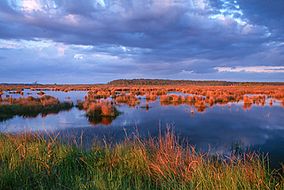Big Branch Marsh National Wildlife Refuge facts for kids
Quick facts for kids Big Branch Marsh National Wildlife Refuge |
|
|---|---|
|
IUCN Category IV (Habitat/Species Management Area)
|
|
 |
|
| Location | St. Tammany Parish, Louisiana |
| Nearest city | Lacombe, Louisiana |
| Area | 17,094 acres (6,918 ha) |
| Established | 2001 |
| Visitors | 24,000 (in 2006) |
| Governing body | U.S. Fish and Wildlife Service |
| Website | Big Branch Marsh National Wildlife Refuge |
The Big Branch Marsh National Wildlife Refuge is a special natural area created in 1994. It covers about 17,094 acres, which is like 13,000 football fields! This refuge protects a mix of pine forests, oak groves, and coastal marshlands. It shows what the natural coastline of Lake Pontchartrain used to look like, even though many towns are now growing around it.
Amazing Animals of Big Branch Marsh
This refuge is home to many different animals, including some that are very rare.
- The red-cockaded woodpecker is an endangered bird that lives in pine forests.
- The majestic bald eagle, the national bird of the United States, also finds a safe home here.
- The brown pelican, a large coastal bird, is another endangered species protected in the refuge.
Other animals you might spot include:
- Quick rabbits
- Wild turkeys
- Many kinds of neo-tropical birds (birds that travel from warmer places)
- Graceful deer
- Busy squirrels
- Migratory waterfowl (birds that fly long distances, like ducks and geese)
- Wading birds (birds with long legs that walk in shallow water)
Unique Habitats of the Refuge
The Big Branch Marsh Refuge has several special areas, called habitat zones, each with its own mix of plants.
- Sandy Beach Zone: This zone is right along the edge of Lake Pontchartrain. It has sandy beaches where the land meets the water.
- Brackish Marsh Zone: Moving inland from the beach, you'll find the brackish marsh. "Brackish" means the water is a mix of fresh and saltwater.
- Wetland Plant Zone: The next area has water levels just below the marsh floor. Here, you'll mostly see plants like wiregrass and spike rush.
- Upland Forest Zone: The farthest inland zone is the upland area. It has tall pine flatwoods and bottomland hardwood hammocks. "Hammocks" are small groves of trees, often on slightly higher ground.
Restoring the Refuge After Storms
In 2005, Hurricane Katrina caused a lot of damage to the refuge. But people worked hard to fix and restore it!
- The Boy Scout Road Trail boardwalk was destroyed, but a new and better one was built in 2007.
- Other buildings and facilities were also repaired or rebuilt.
- Many marsh plants were damaged, and thousands of trees were lost.
- New trees were planted in 2006, 2007, and 2008 to help the forest grow back.
- In 2008, a special project helped restore the marsh in the Goose Point and Point Platte areas.
- Christmas tree fences were used in some marsh areas. These fences are made from discarded Christmas trees. They help slow down waves, trap mud and sand, and prevent the land from washing away. This helps the marsh heal and grow stronger.

All content from Kiddle encyclopedia articles (including the article images and facts) can be freely used under Attribution-ShareAlike license, unless stated otherwise. Cite this article:
Big Branch Marsh National Wildlife Refuge Facts for Kids. Kiddle Encyclopedia.

